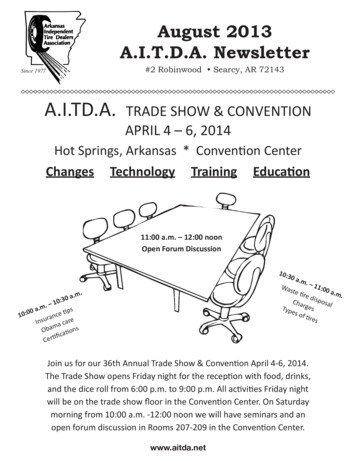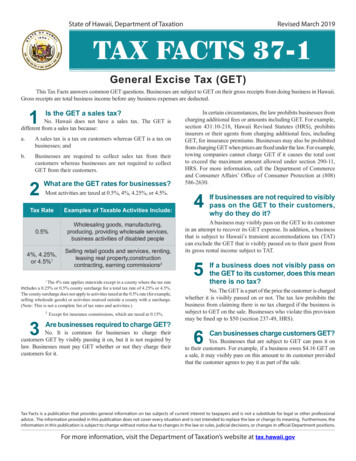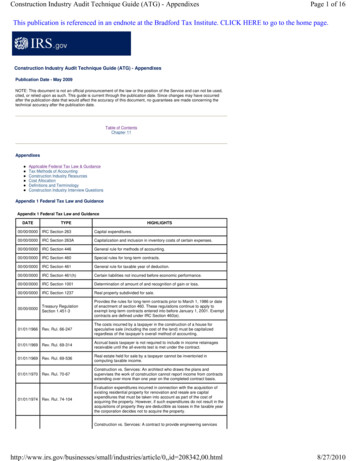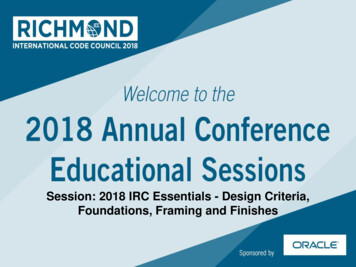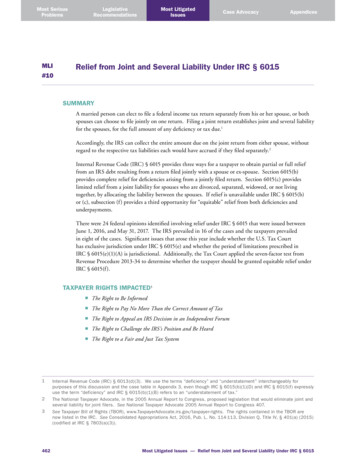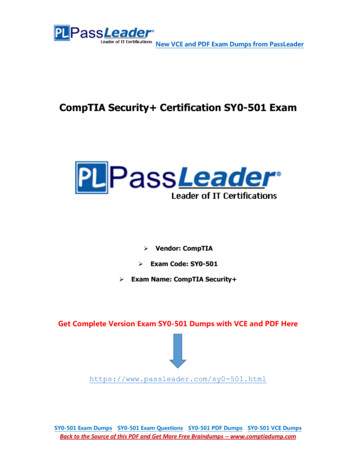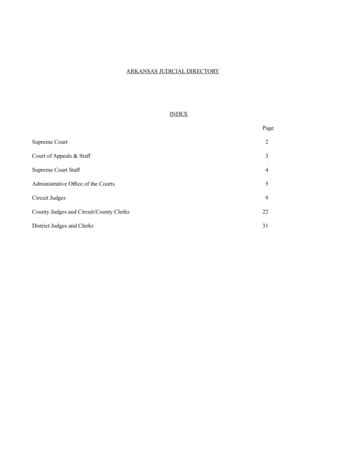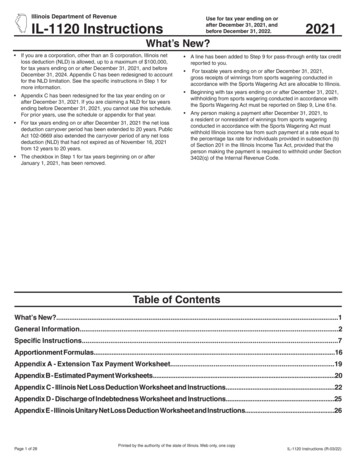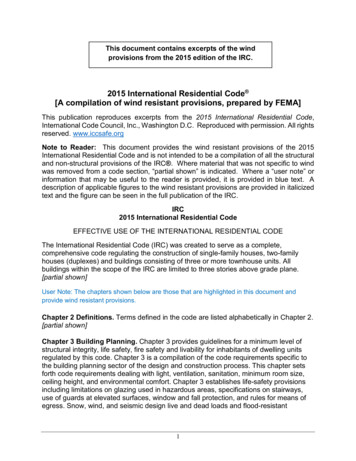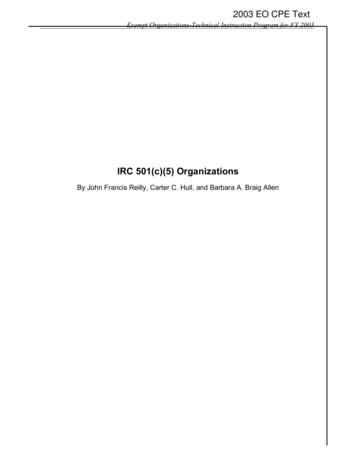
Transcription
2003 EO CPE TextExempt Organizations-Technical Instruction Program for FY 2003IRC 501(c)(5) OrganizationsBy John Francis Reilly, Carter C. Hull, and Barbara A. Braig Allen
Exempt Organizations-Technical Instruction Program for FY 2003IRC 501(c)(5) OrganizationsBy John Francis Reilly, Carter C. Hull, and Barbara A. Braig AllenOverviewPurposeIRC 501(c)(5) provides for the exemption from federal income tax of labor,agricultural, or horticultural organizations. As of March 31, 2002, there were58,962 organizations recognized as tax-exempt under IRC 501(c)(5). Thisarticle will address the requirements an organization must meet to qualify forrecognition as exempt under IRC 501(c)(5).The Appendices contain checksheets and instructions for Project Code #207,501(c)(5) Labor Organizations.Rules relating to the political campaign and lobbying activities of IRC501(c)(5) are the subject of a separate article.In This ArticleThis article contains the following topics.TopicOverviewA. Statutory HistoryB. Labor Organizations1. Definition2. Membership3. Principal Purposes4. Qualifying Activities5. Non-qualifying Activities6. Financial Aid to MembersC. Agricultural and Horticultural Organizations1. Purpose Issuesa) Definitionsb) Principal Purposesc) Qualifying Activitiesd) Non-qualifying ActivitiesSee Page13445891524252525272831Continued on next pageIRC 501(c)(5) Organizations – page J-1
Exempt Organizations-Technical Instruction Program- for FY 2003Overview, ContinuedIn This Article, continued2. Membership Issuesa) Qualifying Activitiesb) Non-qualifying Activitiesc) Sales ActivitiesD. Classification Problems1. IRC 501(c)(5) v. IRC 501(c)(3)2. IRC 501(c)(5) v. IRC 501(c)(6)3. Other Conflicts in ClassificationE. Inurement1. Inurement prohibition2. Excess benefit under IRC 4958Appendix A - Project #207 Checksheet: 501(c)(5) LaborOrganizationAppendix B - Special Processing Instructions: Project Code 207– Labor OrganizationsAppendix C - Project #207 Checksheet: 501(c)(5) LaborOrganization – Non-filersAppendix D - Special Processing Instructions: Project Code 207– Labor Organizations – Non-filersDetailed Subject DirectoryIRC 501(c)(5) Organizations – page J-233333536373739414242424351536164
Exempt Organizations-Technical Instruction Program for FY 2003A. Statutory HistoryTariff Act of1909An income tax exemption for labor agricultural or horticultural organizationswas first provided in the Corporation Excise Tax Act of 1909.The legislative history of IRC 501(c)(5) and other relevant tax statutesprovide a useful definition of labor organizations for purposes of applyingIRC 501(c)(5). Congress first exempted labor organizations from the generalcorporate tax levied by the Tariff Act of 1909. Tariff Act of 1909, ch. 6, § 38,36 Stat. 113. The bill, as sent to the Senate Finance Committee, included theterm "labor organization." The term was eliminated in committee asunnecessary. At the time the committee felt that the wording "fraternalbeneficiary societies, *** operating under the lodge system and providing forthe payment of life, sick, accident, and other benefits" was sufficient. 44Cong. Rec. at 4148-49.Among others, the Brotherhood of Local Firemen expressed concern thattheir organization would not be exempt. These organizations, which did notprovide life, sick, accident, and other benefits to their members, might not beconsidered "beneficiary societies." 44 Cong. Rec. at 4154. The phrase "labororganization" consequently was added to the statute to cover organizationsthat do not "make such provisions, and are not organized for those purposes."44 Cong. Rec. at 4155. In 1913, passage of the first income tax act excluded"labor, agricultural, or horticultural organizations" from income tax liability.Tariff Act of 1913, ch. 16, § 11(G), 38 Stat. 172. Subsequent tax bills andrevisions have maintained this language.In 1976, IRC 501(g) was added to the Code to define “agriculture” as the artor science of cultivating land, harvesting crops or aquatic resources, or raisinglivestock. The provision was enacted to clarify that harvesting aquaticresources should be recognized as an agricultural pursuit. The legislativehistory indicates that organizations engaged in harvesting aquatic food wereencountering difficulty in qualifying for reduced postal rates. See S. Rep. No.94-938 at 419, 420, reprinted in 1976-3 C.B. (vol. 3) 457-458.IRC 501(c)(5) Organizations – page J-3
Exempt Organizations-Technical Instruction Program- for FY 2003B. Labor Organizations1. DefinitionWhat Is a"LaborOrganization?"The term "labor" is commonly accepted as meaning the performance ofservice as employees. Rev. Rul. 78-288, 1978-2 C.B. 179, citing Rev. Rul.76-420, 1976-2 C.B. 153.General usage defines a labor organization as:·An association of workers·Who have combined to protect or promote the interests of the members·By bargaining collectively with their employers·To secure better working conditions, wages, and similar benefits.The term embraces labor unions, councils, and committees."Labor union" is a somewhat narrower term than "labor organization."Labor unions are labor organizations, but not all labor organizations arelabor unions. IRC 501(c)(5) labor organizations do not need to berecognized labor unions.IRC 501(c)(5) Organizations – page J-4
Exempt Organizations-Technical Instruction Program for FY 2003B. Labor Organizations2. MembershipCompositionA labor organization is generally composed of employees or representativesof the employees (collective bargaining agents) and similar groups.The composition of the organization is not as important as are the purposesfor which it is formed and operated.Example:An apprenticeship committee consisted of representation by both employeesand employers equally. The committee was organized primarily:· To establish standards of employment for apprentices in various skilledcrafts,· To determine the qualifications necessary to become a journeyman,· To aid in adjusting and settling disputes between the employer and theapprentice, and· To cooperate with the local board of education in establishingsupplementary classroom instruction pertaining to the apprentice'svocation.The composition of the committee was not within the usual meaning of “labororganization,” i.e., representatives of employees in the form of collectivebargaining agents or similar employees.The primary objectives of the apprenticeship committee improved the lot ofthe apprentices by:· Establishing standards as to wage requirements,· Improving working conditions,· Helping to settle disputes between apprentices and employers,· Establishing the number of apprentices which will be employed in atrade, and· Providing for on-the-job training with required supplemental education inthe classroom.In addition, the committee was not operated for the profit of any individual.Because the committee meets the requirements of Reg. 1.501(c)(5)-1, i.e.,· Has no net earnings inuring to the benefit of any member, and,· Has as its objectives:· The betterment of the conditions of those engaged in such pursuits,· The improvement of the grade of their products, and· The development of a higher degree of efficiency in their respectiveoccupation;it is exempt from taxation as a labor organization. Rev. Rul 59-6, 1959-1C.B. 121.Continued on next pageIRC 501(c)(5) Organizations – page J-5
Exempt Organizations-Technical Instruction Program- for FY 2003B. Labor Organizations2. Membership, ContinuedAn organization was formed to better the conditions of its members, all ofwhom were engaged in a particular trade.Self-employedMembers···The organization worked for better wages and working conditions of itsmembers.Most of the members were employees, though the membership didinclude some self-employed persons.The organization stated that the self-employed were members, sincethey believed the organization's activities better their conditions as well.The organization is exempt under IRC 501(c)(5). Rev. Rul. 74-167, 1974-1C.B. 134.Nurses: SelfemployedAn organization of nurses opened membership to all persons:· Engaged in the profession,· Who were graduates of an accredited school of nursing, and· Who were licensed to practice in at least one state.The purpose of the organization was to promote the professional andeducational advancement of nurses, and to promote the improvement ofnursing services.·····The members of the organization were employed by various institutions,organizations, and doctors in the state.A small percentage of the nurses were independent contractor private dutynurses.The primary activity of the organization was to act as a collectivebargaining agent for its members in contract negotiations between thevarious institutions and the nurses employed by them.The organization also operated a health and welfare fund funded bymember dues.The organization:· Sponsored a biennial convention,· Pperated periodic workshops, conferences and institutes, and· Provided scholarships for continuing education.The organization meets the requirements of IRC 501(c)(5). The inclusion ofa small percentage of independent contractors in its membership does notaffect its exempt status. Rev. Rul. 77-154, 1977-1 C.B. 148.Continued on next pageIRC 501(c)(5) Organizations – page J-6
Exempt Organizations-Technical Instruction Program for FY 2003B. Labor Organizations2. Membership, ContinuedEntrepreneursand IndependentContractorsAn organization was formed to advance the interests of its members whowere drivers, trainers and horse owners engaged in harness racing in aspecific geographic area.·The organization negotiated with the operators of area raceways forlarger purses, better hours and safer operating conditions.·In addition to agreed amounts received from horse owners for feeding,care-taking, exercising, and managing a horse, or for driving a horse, thetrainer and driver of a winning horse each received a percentage of theowner's purse.·Most of the trainers and drivers were entrepreneurs or independentcontractors for purposes of IRC 1402 rather than employees.Where most of an organization's members are entrepreneurs or independentcontractors, the organization does not meet the requirements of IRC501(c)(5). Rev. Rul. 78-288, 1978-2 C.B. 179.Retired MembersAn organization composed of retired employees can qualify for exemptionas a labor organization under IRC 501(c)(5) where it acts to secure andmaintain retirement benefits for its members.IRC 501(c)(5) Organizations – page J-7
Exempt Organizations-Technical Instruction Program- for FY 2003B. Labor Organizations3. Principal PurposesWhat Is thePrincipalPurpose of aLaborOrganization?The principal purposes of a labor organization must be:·The betterment of the conditions of those engaged in a common pursuit,·The improvement of the grade of their products, and·The development of a higher degree of efficiency in their respectiveoccupations. Reg. 1.501(c)(5)-1.These purposes may be accomplished by a single labor organization actingalone, or by several organizations acting together through a separateorganization.IRC 501(c)(5) Organizations – page J-8
Exempt Organizations-Technical Instruction Program for FY 2003B. Labor Organizations4. Qualifying ActivitiesLaborNewspaperA corporation owned by several labor unions engaged solely in publishing anewspaper containing only matters concerning union activities (organizedlabor).···The paper carried no advertising.It was distributed to the members of the unions and other interestedmembers of the public.Publication costs were borne pro rata by several labor organizations.The Service determined that:··Furnishing information about union activities to members is anappropriate function for a labor union, andPublishing a newspaper of this type is an exempt function of an exemptorganization.The nature of the activities is the controlling factor, not the fact that theactivities are carried out on behalf of several labor organizations. Rev. Rul.68-534, 1968-2 C.B. 217."LaborTemple"A corporation operated a “labor temple” containing offices, meeting andrecreation halls, a barber shop, etc., and otherwise “provided a home” forseveral labor unions in the community.All the stock of the corporation was owned by the unions and their members.While the corporation did not maintain employment facilities, the shareholderunions did. Individual members of the unions frequently used the building astheir headquarters for the purpose of obtaining seasonal employment throughfacilities offered by the unions.The corporation’s affairs were conducted with a view toward making receiptsand expenses equal, so that the operation as a whole would not produce aprofit.The Board of Tax Appeals ruled that the organization was exempt under IRC501(c)(5) as a labor organization organized to protect and promote theinterests of labor. The court added, however, that exemption would beretained only so long as the organization confined its circumstances andactivities within the limits described above. It is significant to note that theuse of the facilities by casual guests (less than 2 percent) was regarded asimmaterial. Portland Cooperative Labor Temple Association v.Commissioner, 39 B.T.A. 450 (1939).Continued on next pageIRC 501(c)(5) Organizations – page J-9
Exempt Organizations-Technical Instruction Program- for FY 2003B. Labor Organizations4. Qualifying Activities, ContinuedDispatch HallAn organization was established:·Pursuant to a collective bargaining agreement between a labor union andan association of employees·For the principal purpose of operating a dispatch hall·To allocate work assignments among eligible union members.Union members operated the dispatch hall under the supervision of a jointcommittee.The committee was composed of an equal number of employer and unionrepresentatives.The parent labor union and the parent employer association provided fundingon an equal basis.In addition to maintaining and operating the dispatch hall, the organization·Decided questions regarding rotation of work crews and extra men·Investigated and adjudicated grievances and disputes that arise· In connection with working conditions· The job performance of union members· The operations of the hall.So long as the organization’s activities are not an independent undertaking,but are conducted in conjunction with and in furtherance of the objectives andactivities of a parent labor union to benefit the union members, they areappropriate and traditional union functions.The fact that the dispatch hall, operated by union members, is under thesupervision of a joint committee composed of an equal number of employerand union representatives and jointly funded by equal annual contributions ofthe parent labor organization and the employer association, does not precludeexemption under IRC 501(c)(5). Rev. Rul. 75-473, 1975-2 C.B. 213.Continued on next pageIRC 501(c)(5) Organizations – page J-10
Exempt Organizations-Technical Instruction Program for FY 2003B. Labor Organizations4. Qualifying Activities, ContinuedPublicEmployeesRepresentativeAn organization was created by exempt labor unions representing publicemployees.·······The primary purpose of the organization was to better the conditions ofpublic employees throughout the United States.Its membership was composed of exempt labor organizations thatcontrolled the organization by electing its directors.The organization coordinated legislative, legal, and public relations effortsof its member organizations.It activities included working for the enactment of legislation favorable toall public employees.The organization held meetings, and published documents expressing theinterest of such employees.The primary activity of the organization was supporting litigation ofcommon interest.The organization filed amicus curiae briefs on behalf of its memberorganizations or individual employees where the litigation was in theinterest of all public employees.Litigation support for the purpose of improving the conditions of publicemployees is consistent with the statutory requirements of IRC 501(c)(5).Therefore, the organization qualifies for exemption under that subparagraph.Rev. Rul. 74-596, 1974-2 C.B. 167.Legal DefenseFundAn organization, composed of law enforcement officers, was formed topromote the welfare of these officers.·The organization advanced programs for improved working conditionsand mitigating the hazards inherent in law enforcement.·Membership dues provided support for office expenses, salaries and legalfees.·The organization also represented members in matters of wages and hoursof labor.·As a minor activity, it provided funds for counsel when legal action wasbrought against members in the execution of official duties.Continued on next pageIRC 501(c)(5) Organizations – page J-11
Exempt Organizations-Technical Instruction Program- for FY 2003B. Labor Organizations4. Qualifying Activities, ContinuedLegal DefenseFund,continuedProviding funds for counsel in these cases of legal action does not adverselyaffect the organization's IRC 501(c)(5) exemption. Rather, by providing suchfees the organization was attempting to improve the conditions ofemployment. This effort also encouraged the development of a higher degreeof efficiency among law enforcement officers. Thus, paying legal defense ofthis type is a proper activity of a labor organization. Rev. Rul. 75-288, 19752 C.B. 212.Association ofTeachersTeachers employed by the school system of a certain city who taught in thecity’s school system formed an association.It was formed:·To improve the professional abilities of its members, and·To secure better salaries and working conditions for them.To accomplish these purposes, the organization:·Sponsored seminars and courses for its members·Participated in state and national conventions of teachers·Bargained collectively·Processed grievances on behalf of its members pursuant to a laborcontract with the local school board.The association also sent out a monthly newsletter to keep its members informed of these activities.The association, by bargaining collectively and processing grievances onbehalf of its members, has as its object the betterment of the conditions of itsmembers. Further, by sponsoring seminars and courses, it promotes a higherdegree of efficiency in the teaching profession.Thus, the association qualifies for exemption under IRC 501(c)(5). Rev. Rul.76-31 1976-1 C.B. 157Continued on next pageIRC 501(c)(5) Organizations – page J-12
Exempt Organizations-Technical Instruction Program for FY 2003B. Labor Organizations4. Qualifying Activities, ContinuedUnion andEmployerStewardshipTrustA trust was organized pursuant to the terms of a collective bargainingagreement.It was intended to foster, promote, and maintain the conditions and provisionscontained in the collective bargaining agreement between certain employersand employees through the use of a single stewardship system encompassingseveral firms in a particular industry.The trust’s purposes included the advancement and growth of the industryand the promotion and maintenance of high production and wage standardswith optimum quality of product and craftsmanship.These purposes were accomplished by maintaining a fund for hiring andcompensating a full-time, multi-company steward who was responsible for:···Investigating complaints filed by employeesAssisting in the settlement of disputesAssuring that employers complied with the terms of the collectivebargaining agreement.Because the primary activity of the trust was to furnish a multi-companystewardship system that operated essentially to represent employees and topromote the betterment of their working conditions, it qualifies for exemptionunder IRC 501(c)(5). Rev. Rul. 77-5, 1977-1 C.B. 146.Apprenticeshipand TrainingCommitteeA trust was founded by the local chapters of a union and an employers’association of a particular industry in connection with a collective bargainingagreement.·It regularly conducted educational courses and programs at the unionhall in various aspects of the trade for the local union members,employees, or associations of the industry.·Experienced journeymen served as instructors.·The trust also selected apprentices and supervised their trainingprogram.Continued on next pageIRC 501(c)(5) Organizations – page J-13
Exempt Organizations-Technical Instruction Program- for FY 2003B. Labor Organizations4. Qualifying Activities, ContinuedApprenticeshipand TrainingCommittee,continued·The aim of these activities was to ensure that local standards on thequality of work conformed with national codes for the industry.·The trust also had an affirmative action plan that was approved by theU.S. Department of Labor.The trust was devoted to improving the grade of the industry’s products anddeveloping a higher degree of occupational efficiency. Accordingly, itqualifies for exemption under IRC 501(c)(5). Rev. Rul. 78-42, 1978-1 C.B.158.Strike andLockout FundAn organization was formed by a labor union to provide financial assistanceto members of the union during strikes and lockouts.·The executive board of the union also controlled the organization.·Members of the union supported the organization.·The organization disbursed funds to members who were not working asa result of a strike or lockout.Strike benefits may further a labor union’s primary purpose of representingmembers in matters of wages, hours of labor, working conditions, etc.Therefore, the organization is exempt as a labor organization described inIRC 501(c)(5). Rev. Rul. 67-7, 1967-1 C.B. 137.Continued on next pageIRC 501(c)(5) Organizations – page J-14
Exempt Organizations-Technical Instruction Program for FY 2003B. Labor Organizations5. Non-qualifying ActivitiesProvidingEmployment toMembersThrough aBusinessActivityAn organization carried on a business activity owned and controlled by alabor union.·It was organized to furnish employment to members of the union.·Wages were paid to the union members employed and the profits wereturned over to the union treasury.A business formed to employ union members is not a labor organization inthe commonly accepted sense, and is not exempt under IRC 501(c)(5).Furthermore, because of IRC 502, which addresses “feeder organizations,”the organization cannot be exempt simply on the grounds that the profits fromits business activity are paid over to an exempt organization. Rev. Rul. 69386, 1969-2 C.B. 123.Collection ofEmploymentTaxesAn association of manufacturers and a labor union, created through acollective bargaining agreement, an organization to receive employmenttaxes.·The manufacturers were required to deduct these taxes from their unionemployees and pay the amounts to federal and state revenue departments.·A committee, consisting of representatives of the manufacturers’associations and the labor union, administered the organization.The organization is not exempt under IRC 501(c)(5) because it does not serveany of the exempt purposes articulated in that section. Rev. Rul. 66-354,1966-2 C.B. 207.Continued on next pageIRC 501(c)(5) Organizations – page J-15
Exempt Organizations-Technical Instruction Program- for FY 2003B. Labor Organizations5. Non-qualifying Activities, ContinuedSavings PlanA union and an employers’ association with equal representation established asavings plan pursuant to a collective bargaining agreement.·Under the plan, a set amount was withheld from each union member’spay and deposited in a bank account.·These amounts earned interest during the course of the year.·The organization paid administrative expenses from the fund.·Any amounts that remained after administrative expenses were paid,were paid to the members annually on a fixed date.This organization does not qualify for exemption under IRC 501(c)(5)because its activities are not those commonly or historically recognized asthose characteristic of labor organizations.These traditional characteristics are negotiating wages, hours, and workingconditions. In addition, labor organizations may provide death, sickness, andaccident benefits to members. Rev. Rul. 77-46, 1977-1 C.B. 147.Strike FundControlled byPrivateIndividualsPrivate individuals controlled a particular organization that paid weeklyincome to its members in the event of a lawful strike called by the member’slabor union.·Members paid an annual fee to the organization.·The organization had no authority to represent or speak for its members inmatters relating to their employment, such as wages, hours of labor,working conditions, or economic benefits.The organization was not controlled by, or connected with, any of the labororganizations to which the members belonged.IRC 501(c)(5) Organizations – page J-16
Exempt Organizations-Technical Instruction Program for FY 2003B. Labor OrganizationsA. Statutory HistoryStrike FundControlled byPrivateIndividuals,continuedThe organization is not a “labor organization” in the commonly acceptedsense of the term. Furthermore, it did not make the weekly payments with theobjective of bettering the conditions of employment. Accordingly, it does notqualify for exemption under IRC 501(c)(5). Rev. Rul. 76-420, 1976-2 C.B.153.Pension TrustFundsOn July 29, 1997, T.D. 8726 was issued. It contained new Reg. 1.501(c)(5)1(b)(1) to clarify the status of pension trust funds under IRC 501(c)(5).Reg. 1.501(c)(5)-1(b)(1) provides that an organization whose principalactivity is to receive, hold, invest, disburse or otherwise manage fundsassociated with savings or investment plans or programs, including pension orother retirement savings plans or program is not a labor organization. Thisregulation became effective December 21, 1995. However, if an organizationmeets all of the following requirements, it will be considered a labororganization under 501(c)(5).(i)It is established and maintained by another labororganization described in section 501(c)(5), (determinedwithout regard to this paragraph (b)(2));(ii)It is not directly or indirectly established or maintained inwhole or in part by one or more –(A) Employers;(B) Governments, agencies or instrumentalities thereof; or(C) Government controlled entities;(iii)It is funded by membership dues from members of thelabor organization described in this paragraph (b)(2) andearnings thereon;(iv)It has not at any time after September 2, 1974 (the date ofenactment of the Employee Retirement Income SecurityAct of 1974 [ERISA], Pub. L. No. 93-406, 88 Stat. 829)provided for, permitted, or accepted employercontributions.Continued on next pageIRC 501(c)(5) Organizations – page J-17
Exempt Organizations-Technical Instruction Program- for FY 2003B. Labor OrganizationsA. Statutory History, ContinuedPension TrustFunds,continuedReg. 1.501(c)(5)-1(b)(2) contains an example of a trust whose principalactivity is to hold, invest, disburse or otherwise manage funds associatedwith a retirement savings plan and which does not satisfy all therequirements of Reg. 1.501(c)(5)-1(b)(2) exception. For example, itaccepts contributions from employers. The example provides that the trustis not a labor organization under IRC 501(c)(5).Reg. 1.501(c)(5)-1(b) reflects the government’s nonacquiesence inMorganbesser v. United States, 984 F.2d 560 (2d Cir. 1993), nonacq. 1995-2C.B. 2, A.O.D. CC-1995-016 (Dec. 26, 1995).ERISAIRC 501(a) exempts from federal income tax, organizations described in IRC401(a) or 501(c). Therefore, IRC 401(a) and 501(c)(5) should be read asenactments of Congress that comprise one consistent body of law. PacificCo. v. Johnson, 285 U.S. 480, 495 (1932).ERISA imposed more stringent rules on pension plan trusts that soughtexemption from federal tax. Congress intended that pension trusts satisfy thecomprehensive requirements of IRC 401(a), as amended by ERISA. See S.Rep. No. 383, 93d Cong., 1st Sess., at 33, reprinted in 1974-3 C.B. (Supp.)112; H. Rep. No. 807, 93d Cong. 1st Sess., at 33, reprinted in 1974-3 C.B.(Supp.) 236, 266.Under this regime, an organization whose principal purpose is managingemployer-sponsored retirement plans is not an exempt labor organizationdescribed in IRC 501(c)(5). However, an employer-sponsored pension planmay nevertheless qualify for exemption under IRC 501(a) if it meets therequirements of IRC 401(a).Continued on next pageIRC 501(c)(5) Organizations – page J-18
Exempt Organizations-Technical Instruction Program for FY 2003B. Labor OrganizationsA. Statutory History, ContinuedERISA,continuedAccordingly, consistent with ERISA and interpreting IRC 401(a) and IRC501(c)(5) as part of a consistent whole, Reg. 1.501(c)(5)-1(b)(1) provides ageneral rule. The rule enunciated in the regulation is that an organization isnot described in IRC 501(c)(5) if its principal activity is to receive, hold,invest, disburse or otherwise manage funds associated with savings orinvestment plans or programs, including pension or other retirement savingsplans or programs.·Under ERISA, pension trusts established under IRC 401(a) arerecognized as exempt under IRC 501(a).·Employers’ contributions to these plans are immediately deductibleto the employer. IRC 404(a).·Employees do not declare the amounts as income until actualdistribution. IRC 402(a).Note: Reg 1.892-2T(c) governs the tax status of a pension trust that is whollyowned and controlled by a foreign sovereign.PGGMStichting Pensioenfonds Voor de Gezondheid, Geestelijke enMaatschappelijke Belangen [PGGM] v. United States, 950 F. Supp. 373(D.D.C. 1996) aff’d 129 F.3d 195 (D.C. Cir. 1997), cert. denied, 525 U.S. 811(1998), involved a multi-employer pension plan [“Fund”] for Dutch healthcare workers.·Negotiations between the Dutch National Hospital Employers’Association and three labor unions established the Fund in June 1969.·The Fund collected pension fund contributions paid by employers andemployees.·The Fund invested in U.S. stocks and mutual funds.·A Board of Directors, half appointed by the principal employers and halfappointed by the three principa
Temple" A corporation operated a "labor temple" containing offices, meeting and recreation halls, a barber shop, etc., and otherwise "provided a home" for several labor unions in the community. All the stock of the corporation was owned by the unions and their members.

